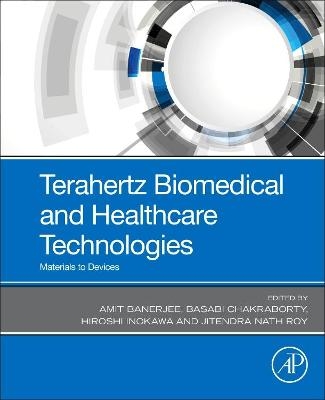
Terahertz Biomedical and Healthcare Technologies
Elsevier Science Publishing Co Inc (Verlag)
978-0-12-818556-8 (ISBN)
Dr. Amit Banerjee is an assistant professor and group leader at the Microsystem Design-Integration Lab, Physics Department, Bidhan Chandra College, Asansol, West Bengal, India. Basabi Chakraborty received B.Tech, M.Tech and Ph.D degrees in RadioPhysics and Electronics from Calcutta University, India and worked in Indian Statistical Institute, Calcutta, India until 1990. From 1991 to 1993 she worked as a part time researcher in Advanced Intelligent Communication Systems Laboratory in Sendai, Japan. She received another Ph. D in Information Science from Tohoku University, Japan in 1996. From 1996 to 1998, she worked as a postdoctoral research fellow in Research Institute of Electrical Communication, Tohoku University, Japan. In 1998 she joined as a faculty in Software and Information Science department of Iwate Prefectural University, Iwate, Japan. Currently she is serving as Professor and Head of Pattern Recognition and Machine Learning laboratory in the same department. Her main research interests are in the area of Pattern Recognition, Machine Learning, Soft Computing Techniques, Biometrics, Data Mining and Social Media Data ining. She is a senior member of IEEE, member of ACM, Japanese Neural Network Society (JNNS), Japanese Society of Artificial Intelligence (JSAI), and Executive committee member of ISAJ (Indian Scientists Association in Japan). She served as the chair of IEEE JC WIE (Women in Engineering) during 2010-2011. She also served as the founder chair of IEEE WIE Sendai section during 2017-2018. Currently she is executive committee member of IEEE R10 WIE, IEEE JC WIE and Sendai WIE. Hiroshi Inokawa received B.S., M.S., and Ph.D. degrees in electrical engineering from Kyoto University, Japan in 1980, 1982 and 1985, respectively. In 1985, he joined the Atsugi Electrical Communications Laboratories, Nippon Telegraph and Telephone Corporation (NTT), Kanagawa, Japan. Since then, he has been engaged in the research and development of scaled-down CMOS devices and silicon single-electron devices. During the course of his research, he invented the basic structure of FinFET in 1989 and single-electron multiple-valued logic in 2001, and received IEEE International Symposium on Multiple-Valued Logic (ISMVL) Outstanding Contributed Paper Awards in 2004 and 2006, Director's Award of NTT Basic Research Laboratories in 2004, 28th JSAP Award for the Best Original Paper in 2006, etc. In 2006, he became a professor of the Research Institute of Electronics, Shizuoka University, Hamamatsu, Japan, where he has been studying nanodevices for advanced circuits and systems. His recent work on SOI MOSFET single-photon detector was introduced by IEEE Photonics Journal in 2012 as a Breakthrough in Photonics. Prof. Inokawa is a member of the Institute of Electrical and Electronics Engineers (IEEE), the Japan Society of Applied Physics (JSAP), the Institute of Electronics, Information and Communication Engineers of Japan (IEICE), and the Institute of Electrical Engineers of Japan (IEEJ). He has served as a JSAP board member of representative in 2001-2003, an editor of JJAP in 2007-2013, the chair of the IEEJ survey committee of silicon nanosystem integration technology in 2009-2011, an advisory committee member of NICT Japan Trust International Research Cooperation Program in 2006-2009, a researcher of National Institute of Science and Technology Policy (NISTEP) in 2002-present, etc. Jintendra Nath Roy received M Sc and Ph D degree in Physics from Vidyasagar University, India. He had joint research program at Department of Electrical and Computer Engineering, Light wave Communications Research Group, Xanthi-Greece. Prof. Roy received International Sardar Patel Award from Sardar Vallabhbhai Patel Foundation for significant contribution in physical science. Dr. Roy has 20 years of experience in teaching research and administration. Presently Dr. is working as a Professor and Dean (science) in Dept. of Physics at Kazi Nazrul University, Asansol, WB, India. He has already published more than 123 research papers in peer reviewed journals and conference proceedings. Dr. Roy received research grant from AICTE, Govt of India, under FRS Scheme for research in “Designing of an all-optical conversion scheme from binary to its Modified Trinary Number. Dr. Roy is member of many International Advisory Committees, Technical Program Committees in various countries, acted as Panel Editor, Reviewer for reputed journals. Prof. Roy has produced 9 PhD students in different topics of Applied optics and photonics, linear & nonlinear optical material, laser. His current research interest is in Terahertz Optical Asymmetric Demultiplexer (TOAD) based switch in Computing, Communication and Control.
Section I: Terahertz Detectors and Sources: Design and Fabrication Aspects 1. THz Solid-State Source Based on IMPATT Devices 2. Terahertz Sources Based on Difference-Frequency Generation for Spectroscopy and Biomaterial Analysis 3. Advanced Materials and Structures for Terahertz Engineering 4. 2D Materials as THz Generators, Detectors, and Modulators: Potential Candidates for Biomedical Applications 5. Terahertz Technology – Emerging Trends and Application Viewpoints
Section II: Advanced Medical Imaging, Pattern Recognition and Tomographic Reconstruction 6. THz Medical Imaging: Current Status and Future Outlook 7. A Framework Development on Big Data Analytics for Terahertz Healthcare 8. Medical Imaging, Artificial Intelligence, Internet of Things, Wearable Devices in Terahertz Healthcare Technologies 9. A Survey on Machine Learning Techniques for THz Image Analysis 10. Amalgamation of Machine Learning and Artificial Intelligence for Breast Cancer Detection 11. Terahertz Molecular Imaging and Its Clinical Applications 12. Waveguides for Terahertz Endoscopy 13. Prospects in Medical Applications of Terahertz Waves
| Erscheinungsdatum | 17.08.2020 |
|---|---|
| Sprache | englisch |
| Maße | 191 x 235 mm |
| Gewicht | 540 g |
| Themenwelt | Medizin / Pharmazie ► Physiotherapie / Ergotherapie ► Orthopädie |
| Technik ► Elektrotechnik / Energietechnik | |
| Technik ► Maschinenbau | |
| Technik ► Medizintechnik | |
| ISBN-10 | 0-12-818556-2 / 0128185562 |
| ISBN-13 | 978-0-12-818556-8 / 9780128185568 |
| Zustand | Neuware |
| Haben Sie eine Frage zum Produkt? |
aus dem Bereich


